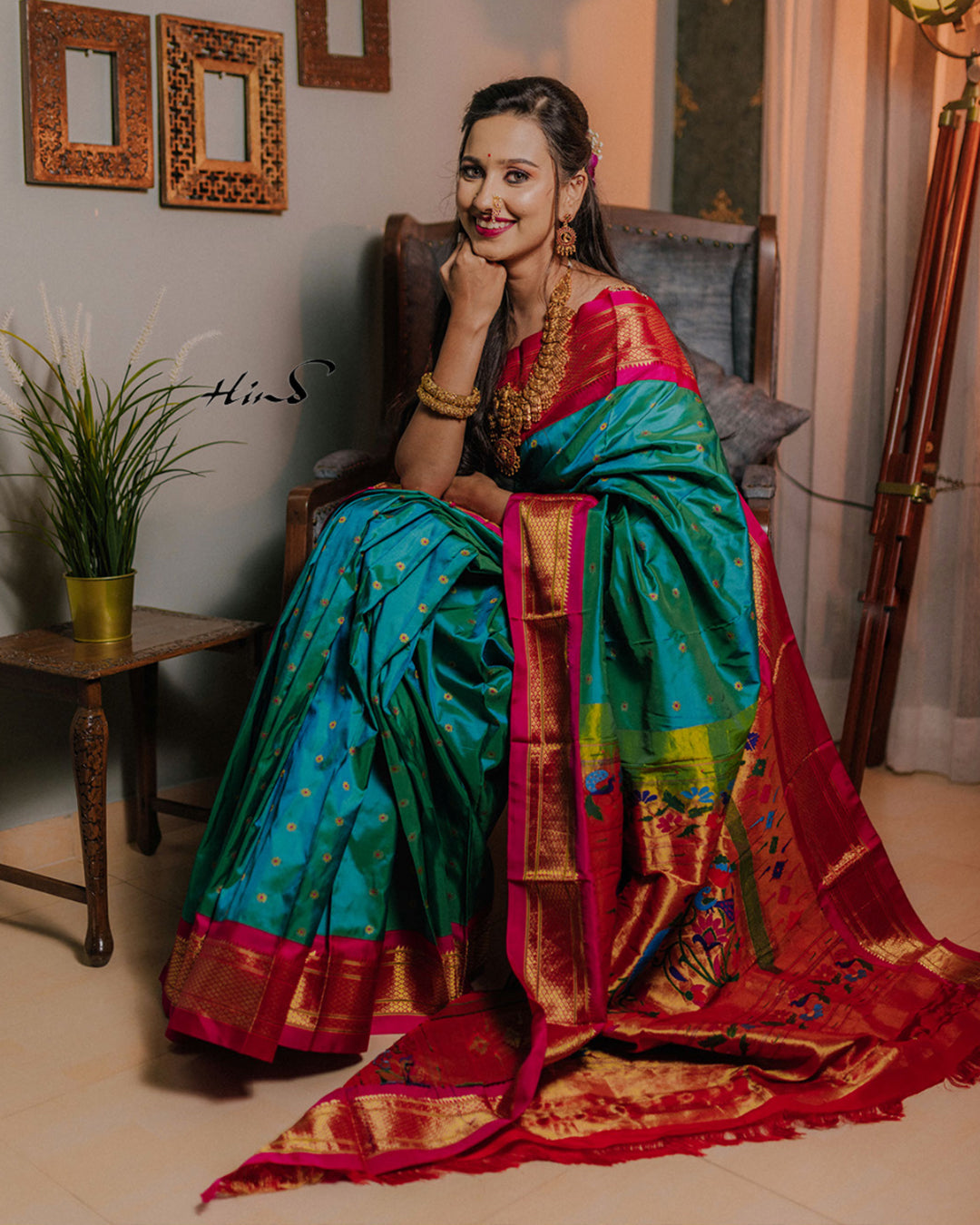Famous Paithani Saree Patterns: Peacock, Lotus, and Beyond

Paithani Saree Patterns: Peacock, Lotus, and Beyond
Paithani sarees are renowned for their intricate motifs, vibrant colors, and luxurious zari work. Each design is steeped in tradition and holds cultural significance, making these sarees a work of art. Among the most iconic patterns are the peacock and lotus, but there are many other motifs that showcase the rich creativity of Paithani artisans. Here’s a closer look at some of the most famous Paithani saree patterns.
1. Peacock (Mor) Motif
-
Significance:
The peacock is the most iconic motif in Paithani sarees, symbolizing grace, beauty, and royalty. -
Placement:
Often featured prominently on the pallu or borders, the peacock design is crafted with vibrant colors and intricate zari detailing. -
Variations:
The Bangdi Mor, where peacocks are enclosed within a circular (bangle-like) frame, is a highly sought-after variation for its elaborate and regal appearance.
2. Lotus (Kamala) Motif
-
Significance:
The lotus motif represents purity, spirituality, and divine beauty, making it a favorite in traditional designs. -
Placement:
Found on the pallu, the lotus motif is often paired with creepers or floral vines for a complete nature-inspired design. -
Design Style:
Lotuses are typically woven in contrasting colors with zari highlights to add a touch of elegance.
3. Parrot (Tota) Motif
-
Significance:
The parrot symbolizes vibrancy, playfulness, and love for nature. -
Placement:
Usually depicted in pairs, parrots adorn the borders and pallu, often in a vivid green color against contrasting backgrounds. -
Appeal:
The parrot motif adds a lively and cheerful vibe to Paithani sarees, making them perfect for festive occasions.
4. Creeper (Asawali) Motif
-
Significance:
The asawali motif, or vine creeper, represents growth, fertility, and the continuity of life. -
Placement:
Woven intricately along the borders or pallu, creepers often frame larger motifs like flowers or animals. -
Design Details:
These delicate patterns are highlighted with zari to create a shimmering effect.
5. Mango (Ambi) Motif
-
Significance:
The mango motif, also known as paisley, is a traditional Indian design representing fertility and prosperity. -
Placement:
Found on borders or scattered across the body of the saree, the ambi motif adds a timeless charm. -
Design Style:
It is often woven with intricate detailing in zari and vibrant silk threads.
6. Narali (Coconut) Motif
-
Significance:
The coconut motif, or narali, symbolizes auspiciousness and prosperity, making it a popular choice for religious and festive occasions. -
Placement:
This motif is primarily found on the borders, adding a touch of tradition and simplicity. -
Design Details:
The pattern is often minimalistic, complementing the elaborate pallu.
7. Shikargah (Hunting Scenes) Motif
-
Significance:
The shikargah motif depicts hunting scenes with animals like deer, elephants, and birds. It symbolizes strength, adventure, and royal legacy. -
Placement:
Found on pallus, this motif is rare and highly detailed, making it a prized design among collectors. -
Artistic Appeal:
These sarees require exceptional skill and are considered masterpieces of Paithani weaving.
8. Geometric Patterns
-
Significance:
Geometric shapes like diamonds, triangles, and squares reflect precision and symmetry, adding a modern edge to traditional designs. -
Placement:
Typically featured on borders or scattered across the body, these patterns provide balance to the elaborate pallu motifs. -
Design Details:
Often highlighted with zari, geometric patterns complement the saree's overall aesthetics.
9. Coin (Asharfi) Motif
-
Significance:
The coin motif, resembling gold coins, represents wealth and prosperity. -
Placement:
Found on the borders or scattered across the body, the asharfi motif adds a touch of opulence. -
Traditional Appeal:
This design is particularly popular in festive or bridal Paithanis.
10. Flowers and Vines
-
Significance:
Floral patterns symbolize beauty, femininity, and nature’s bounty. -
Placement:
Often paired with creepers or as standalone motifs on the pallu or borders. -
Design Style:
Flowers are woven in vibrant silk colors, enhanced with zari highlights.
